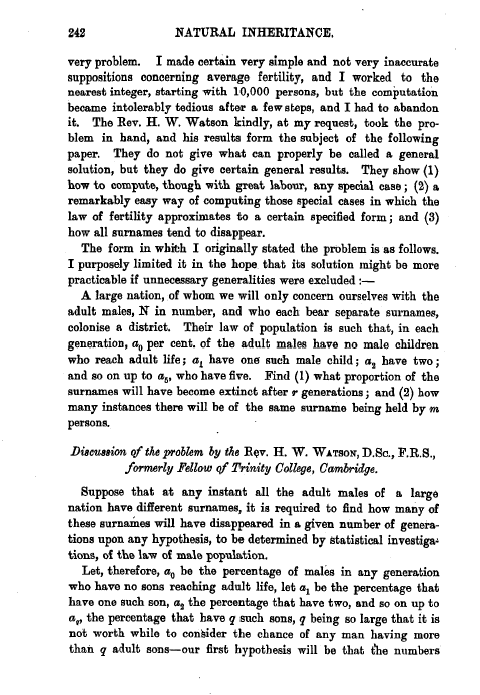242 NATURAL INHERITANCE.
very problem. I made certain very simple and not very inaccurate suppositions concerning average fertility, and I worked to the nearest integer, starting with 10,000 persons, but the computation became intolerably tedious after a few steps, and I had to abandon it. The Rev. H. W. Watson kindly, at my request, took the problem in hand, and his results form the subject of the following paper. They do not give what can properly be called a general solution, but they do give certain general results. They show (1) how to compute, though with great labour, any special case ; (2) a remarkably easy way of computing those special cases in which the law of fertility approximates to a certain specified form; and (3) how all surnames tend to disappear.
The form in which I originally stated the problem is as follows. I purposely limited it in the hope that its solution might be more practicable if unnecessary generalities were excluded :
A large nation, of whom we will only concern ourselves with the adult males, N in number, and who each bear separate surnames, colonise a district. Their law of population is such that, in each generation, ap per cent. of the adult males have no male children who reach adult life ; ai have one such male child ; a2 have two ; and so on up to a8, who have five. Find (1) what proportion of the surnames will have become extinct after r generations; and (2) how many instances there will be of the same surname being held by m persons.
Discussion of the problem by the Rgv. H. W. WATSON, D.Sc., F.R.S.,
formerly Fellow of Trinity College, Cambridge.
Suppose that at any instant all the adult males of a large nation have different surnames, it is required to find how many of these surnames will have disappeared in a given number of generations upon any hypothesis, to be determined by statistical investiga= tions, of the law of male population.
Let, therefore, ao be the percentage of males in any generation who have no sons reaching adult life, let al be the percentage that have one such son, a2 the percentage that have two, and so on up to a0, the percentage that have q such sons, q being so large that it is not worth while to con§ider the chance of any man having more than q adult sons-our first hypothesis will be that the numbers

